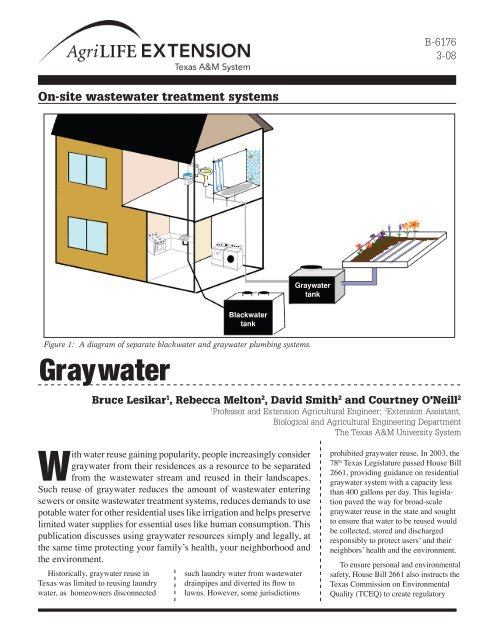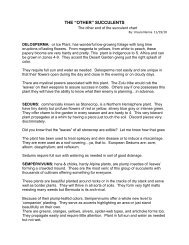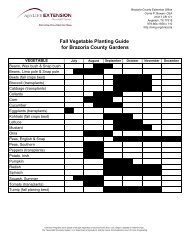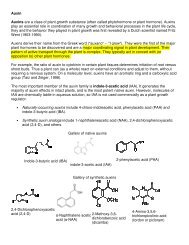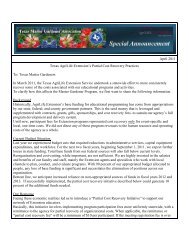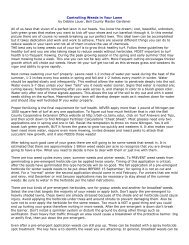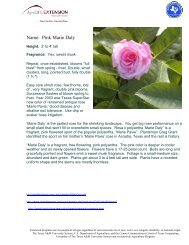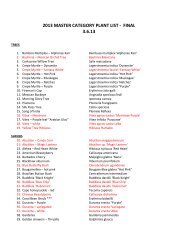Graywater - Texas Master Gardeners Association
Graywater - Texas Master Gardeners Association
Graywater - Texas Master Gardeners Association
Create successful ePaper yourself
Turn your PDF publications into a flip-book with our unique Google optimized e-Paper software.
B-6176<br />
3-08<br />
On-site wastewater treatment systems<br />
Figure 1: A diagram of separate blackwater and graywater plumbing systems.<br />
<strong>Graywater</strong><br />
Bruce Lesikar 1 , Rebecca Melton 2 , David Smith 2 and Courtney O'Neill 2<br />
1<br />
Professor and Extension Agricultural Engineer; 2 Extension Assistant,<br />
Biological and Agricultural Engineering Department<br />
The <strong>Texas</strong> A&M University System<br />
With water reuse gaining popularity, people increasingly consider<br />
graywater from their residences as a resource to be separated<br />
from the wastewater stream and reused in their landscapes.<br />
Such reuse of graywater reduces the amount of wastewater entering<br />
sewers or onsite wastewater treatment systems, reduces demands to use<br />
potable water for other residential uses like irrigation and helps preserve<br />
limited water supplies for essential uses like human consumption. This<br />
publication discusses using graywater resources simply and legally, at<br />
the same time protecting your family’s health, your neighborhood and<br />
the environment.<br />
Historically, graywater reuse in<br />
<strong>Texas</strong> was limited to reusing laundry<br />
water, as homeowners disconnected<br />
such laundry water from wastewater<br />
drainpipes and diverted its flow to<br />
lawns. However, some jurisdictions<br />
prohibited graywater reuse. In 2003, the<br />
78 th <strong>Texas</strong> Legislature passed House Bill<br />
2661, providing guidance on residential<br />
graywater system with a capacity less<br />
than 400 gallons per day. This legislation<br />
paved the way for broad-scale<br />
graywater reuse in the state and sought<br />
to ensure that water to be reused would<br />
be collected, stored and discharged<br />
responsibly to protect users’ and their<br />
neighbors’ health and the environment.<br />
To ensure personal and environmental<br />
safety, House Bill 2661 also instructs the<br />
<strong>Texas</strong> Commission on Environmental<br />
Quality (TCEQ) to create regulatory
guidance for graywater use. Regulatory<br />
guidance for graywater flows is presented<br />
in Title 30 of the <strong>Texas</strong> Administrative<br />
Code, Chapter 285. In <strong>Texas</strong>,<br />
local authorities generally do not issue<br />
permits for systems from single family<br />
residences with daily graywater flow of<br />
less than 400 gallons.<br />
Residential<br />
wastewater<br />
sources<br />
Residential wastewater can be divided<br />
into blackwater and graywater,<br />
depending on its source. The <strong>Texas</strong><br />
Water Code (Code) defines graywater<br />
as water discharged from<br />
showers<br />
bathtubs<br />
handwashing lavatories<br />
sinks (not used for disposal of<br />
hazardous or toxic materials)<br />
sinks (not used for food preparation<br />
or disposal)<br />
clothes-washing machines<br />
The Code’s definition excludes<br />
water discharged after washing<br />
materials soiled with human excreta<br />
(e.g., diapers) and wastewater that has<br />
contacted toilet waste.<br />
Blackwater contains relatively<br />
higher concentrations of nitrogen,<br />
organic matter and human pathogens<br />
than does graywater. Blackwater<br />
includes flush water from toilets and<br />
urinals and wastewater from food<br />
preparation sinks. Fig. 1 illustrates average<br />
daily percentages of graywater<br />
and blackwater from various sources.<br />
<strong>Graywater</strong><br />
separation<br />
To be reused, graywater first<br />
must be separated from blackwater,<br />
upstream of any treatment systems.<br />
Such separation must be done both<br />
Figure 1. Wastewater from blackwater<br />
and graywater sources, by<br />
percentage.<br />
for households equipped with onsite<br />
wastewater treatment systems and for<br />
those plumbed into municipal sewer<br />
systems.<br />
Diversion splits blackwater from<br />
graywater using two separate pipe<br />
collection systems inside a house,<br />
running to appropriate fixtures (Fig.<br />
2). Toilet water can be treated with<br />
technologies such as non-discharging<br />
toilets (incinerating and composting)<br />
or can be directed to a separate onsite<br />
wastewater treatment system. Once<br />
separated, graywater can be diverted<br />
for reuse, such as for landscape irrigation,<br />
or it can be directed first to an<br />
onsite wastewater treatment system for<br />
further treatment. Fig. 3 illustrates the<br />
four primary components of an onsite<br />
wastewater treatment system. <strong>Graywater</strong><br />
diverted by a separation system<br />
would be introduced upstream of its<br />
collection and storage components<br />
of the onsite wastewater treatment<br />
system.<br />
Figure 2. House diagram of separate blackwater and graywater plumbing<br />
systems.
Figure 3. Components of an onsite wastewater treatment system.<br />
backing up into the graywater system.<br />
Water flowing in the desired direction<br />
has enough pressure to lift the flap of<br />
the backwater valve and pass through<br />
it, but sewage flowing the wrong way<br />
forces the flap to stay closed. Two<br />
valves are used as a precautionary<br />
measure, so that just in case one fails,<br />
sewage still cannot back up into the<br />
graywater system.<br />
<strong>Graywater</strong> can be collected,<br />
treated, stored and reused. The type of<br />
wastewater-treatment system chosen<br />
depends on the constituents present in<br />
the graywater and on the level of treatment<br />
desired. In some cases, a settling<br />
tank with a gravity-fed pipe to the<br />
distribution system may be adequate<br />
(Fig. 6). In other cases, graywater can<br />
be sent to a secondary tank from which<br />
Figure 4. Diverted graywater plumbing system.<br />
Diverted plumbing systems require<br />
separate management of blackwater<br />
and graywater sources. Because graywater<br />
systems may be used seasonally,<br />
may need periodic maintenance, or<br />
may be abandoned in the future, a diversion<br />
valve should be placed in the<br />
graywater collection line at the point<br />
where it leaves the residence (Fig. 4).<br />
This diversion valve allows graywater<br />
flow to be directed to the graywater<br />
system or to the onsite wastewater<br />
treatment system (OWTS). If a<br />
residence is connected to a municipal<br />
wastewater treatment system, the<br />
diversion valve will direct graywater<br />
either to the graywater system or to<br />
the municipal collection system.<br />
Overflow from the graywater<br />
system must be diverted to the onsite<br />
wastewater treatment system or to the<br />
municipal system, but two backwater<br />
valves must be installed. A backwater<br />
valve (Fig. 5) allows water to flow<br />
one way (to the onsite wastewater<br />
treatment system or to a municipal<br />
sewer) but prevents effluent from<br />
Figure 5. Backwater valve for<br />
plumb-ing into graywater system<br />
overflow line.<br />
Figure 6. Settling tank for gravity<br />
graywater-distribution system.<br />
it will be pumped to a pressurized<br />
subsurface reuse system (Fig. 7). In a<br />
pressurized system, discharge is regulated<br />
to control graywater application.<br />
Such control can be important when<br />
graywater is reused for irrigation.<br />
With either design, an overflow<br />
pipe must be installed to divert excess<br />
water to the onsite wastewater treatment<br />
system or to the municipal sewer<br />
system. When an onsite wastewater<br />
treatment system is used, however, it<br />
may be easier to treat all wastewater<br />
from a residence for reuse rather than<br />
treat graywater separately. A decision<br />
to divert, collect or treat graywater
Figure 7. Settling tank and pump tank for pressurized graywater distribution.<br />
or to separate wastewater streams at<br />
all should be based on an individual<br />
household’s circumstances and on the<br />
purposes for which graywater will be<br />
reused.<br />
<strong>Graywater</strong><br />
system design<br />
considerations<br />
<strong>Graywater</strong> sources<br />
A homeowner first must decide<br />
which household graywater sources to<br />
collect for reuse. Collecting graywater<br />
from all sources increases the risk of<br />
additional solids and other pollutants<br />
being added to the graywater. Each<br />
source contributes different contaminants<br />
due to its particular water com-<br />
position (Table 1). Constituents likely<br />
to be found in a particular graywater<br />
source should be compared to the<br />
intended reuse application for water<br />
from that source. Such evaluation also<br />
helps to identify treatment necessary<br />
prior to graywater reuse.<br />
<strong>Graywater</strong> yields<br />
The amount of graywater a household<br />
generates depends on number of<br />
occupants, their ages, their lifestyle<br />
characteristics and their water-use<br />
patterns and on the potential graywater<br />
sources to be fed into the system<br />
(Table 2). Total amount of graywater<br />
produced varies from site to site and<br />
must be estimated as part of systemdesign<br />
processes.<br />
<strong>Graywater</strong> collection<br />
and storage<br />
In a limited number of situations<br />
(system in existence prior to January<br />
6, 2005), graywater from residential<br />
clothes-washing machines may be discharged<br />
onto the ground using a gravity<br />
flow system. <strong>Graywater</strong> from other<br />
sources should be diverted through<br />
settling tanks and pump tanks for later<br />
treatment and distribution. However,<br />
graywater contains organic matter,<br />
and if it is stored, it will quickly turn<br />
septic, generate offensive odors and<br />
promote growth of pathogenic microorganisms.<br />
Thus, it is critical to size<br />
the graywater settling tank and pump<br />
tank appropriately, so that they do not<br />
hold graywater for extended periods<br />
of time. Generally, to keep graywater<br />
fresh,it should be stored for less than<br />
one day, a critical consideration if<br />
it is to be dispersed onto the ground<br />
surface.<br />
<strong>Texas</strong> graywater rules also require<br />
that graywater be collected in an approved<br />
tank that<br />
is labeled clearly as “non-potable<br />
water”;<br />
restricts access, especially to<br />
children;<br />
eliminates habitat for mosquitoes<br />
and other vectors;<br />
Table 1. Constituents of wastewater from different sources (Wright, 1996).<br />
Water sources<br />
Bacteria<br />
Bleach<br />
Food particles<br />
Grease and oil<br />
Hair<br />
High pH<br />
Hot water<br />
Nitrogen<br />
Odor<br />
Organic matter<br />
Phosphorus<br />
Salinity<br />
Soap<br />
Sodium<br />
Suspended solids<br />
Turbidity<br />
Shower and bathtub • • • • • • • •<br />
Sinks (other than kitchen) • • • • • • • •<br />
Laundry • • • • • • • • • • • •
Table 2. Estimated residential water use based on house size.<br />
No.<br />
bedrooms<br />
Size of house<br />
(square feet)<br />
Daily water use<br />
(gallons)<br />
Without watersaving<br />
devices<br />
(50%) Daily<br />
graywater<br />
production (gallons)<br />
Daily water use<br />
(gallons)<br />
With watersaving<br />
devices<br />
(50%) Daily<br />
graywater<br />
production (gallons)<br />
1 or 2 Less than 1,500 225 113 180 90<br />
3 Less than 2,500 300 150 240 120<br />
4 Less than 3,500 375 188 300 150<br />
5 Less than 4,500 450 225 360 180<br />
6 Less than 5,500 525 263 420 210<br />
can be cleaned; and<br />
meets structural requirements of<br />
the 2004 American Water Works<br />
<strong>Association</strong> (AWWA) standards.<br />
Settling tank and pump tank capacities<br />
must be adequate for estimated<br />
graywater production, expected storage<br />
time and reuse application. The<br />
graywater settling tank should hold<br />
about one day’s production volume to<br />
limit graywater detention in the tank<br />
to less than a day and to collect gross<br />
solids on the tank bottom. Inlet and<br />
outlet pipes can be close together to<br />
allow fairly direct flow between them.<br />
An effluent screen should be placed in<br />
the outlet piping to collect debris that<br />
might otherwise exit the settling tank<br />
with discharged graywater.<br />
Pump tank capacity is determined<br />
based on the pump’s minimum operating<br />
level, dose volume and alarm<br />
volume. These three factors usually<br />
equate to a pump-tank minimum<br />
volume equal to two days of flow,<br />
assuming graywater will be dosed to<br />
a distribution system daily. However,<br />
pump tanks may be larger, based on<br />
your landscape irrigation schedules.<br />
Some individuals may choose to irrigate<br />
only a couple of times a week,<br />
requiring larger tank capacity.<br />
<strong>Graywater</strong><br />
distribution<br />
Approved reuse applications.<br />
<strong>Texas</strong> graywater regulations allow<br />
graywater to be reused in the following<br />
ways:<br />
around the foundation of a new<br />
house to minimize soil movement<br />
or cracking;<br />
for gardening;<br />
for composting; or<br />
for landscaping at a single family<br />
residence.<br />
To determine the most appropriate<br />
use for graywater, consider the constituents<br />
expected to be in the water,<br />
the constituents to be removed during<br />
treatment processes, and the amount<br />
of graywater available for distribution.<br />
For example, graywater used to<br />
maintain moisture around foundations<br />
would require less treatment than<br />
would graywater used to irrigate saltsensitive<br />
trees or specimen plants.<br />
<strong>Texas</strong> graywater rules dictate<br />
acceptable methods of graywater distribution.<br />
Generally, graywater should<br />
be applied subsurface. Distribution of<br />
graywater using a spray system is forbidden.<br />
Other good-sense guidelines<br />
help protect human and environmental<br />
health:<br />
Edible root crops probably should<br />
not be irrigated with graywater.<br />
Use graywater for well-established<br />
plants rather than for<br />
seedlings.<br />
<strong>Graywater</strong> usually is slightly<br />
alkaline, so avoid using it to water<br />
plants that thrive in acidic soils.<br />
To prevent salt accumulation,<br />
distribute graywater over a large<br />
surface area and rotate distribution<br />
from one area to another.<br />
Select reuse applications appropriate<br />
for the amount of water to<br />
be generated in the system.<br />
Surface discharge exemption.<br />
<strong>Texas</strong> regulations include special rules<br />
for laundry graywater systems in use<br />
before January 6, 2005. According<br />
to 30 TAC Chapter 285 Subchapter<br />
H. Section 285.81, a homeowner that<br />
has been discharging laundry water<br />
directly onto the ground surface<br />
(without a settling tank) since before<br />
January 6, 2005, may continue to do<br />
so if the area onto which the laundry<br />
graywater is applied
does not create a public heath<br />
nuisance,<br />
supports plant growth or is sodded<br />
with vegetative cover,<br />
does not have wet soil,<br />
does not have surface ponding, and<br />
has limited access and use by residents<br />
and pets.<br />
This rule also states that a discharge<br />
line must have a lint trap and that use<br />
of detergents with significant amounts<br />
of phosphorus, sodium or boron should<br />
be avoided. If at any time the system is<br />
altered, creates a nuisance or discharges<br />
water from sources other than a<br />
clothes-washing machine, a previously<br />
exempt laundry graywater system will<br />
no longer be authorized to discharge to<br />
the surface. Such laundry water then<br />
must be directed to a graywater system<br />
meeting current regulations or into an<br />
onsite wastewater treatment system.<br />
<strong>Graywater</strong> systems installed after<br />
January 6, 2005, must follow the<br />
criteria of Section 285.81 that allow<br />
for discharge above the surface so<br />
long as provisions of this section are<br />
met. Under this rule, washing-machine<br />
discharge first must pass through a<br />
graywater settling tank, and the surface<br />
drag hose or piping must be purple to<br />
denote a nonpotable water conduit (Fig.<br />
8). This color requirement can be met<br />
by using pipe painted purple, purple<br />
pipe or pipe taped with purple metallic<br />
tape. Homeowners should discharge<br />
graywater to the surface only from<br />
systems for which laundry graywater is<br />
the exclusive source. If a homeowner<br />
desires to discharge graywater for surface<br />
reuse, other than from a laundry<br />
system, he or she can install a graywater<br />
or secondary treatment system<br />
complying with all rules for onsite<br />
wastewater treatment systems as listed<br />
in Chapter 285 regulations.<br />
Subsurface distribution. Although<br />
surface discharge (except for spraying)<br />
is allowed for treated graywater,<br />
graywater reuse should be distributed<br />
strictly below the soil surface to<br />
o o o o o o o o o o o o o o o o o o o o o o o o o o o o o o o o o o o o o o o o o o o o o o o o o o o o o o o o o o o o o<br />
minimize potential health risks and<br />
odors. An example of subsurface<br />
distribution includes graywater dosed<br />
to a gravel bed or trench underlying a<br />
flowerbed (Fig. 9); water not taken up<br />
Figure 8. Laundry graywater system with small settling tank and drag hose for<br />
irrigation.<br />
Figure 9. <strong>Graywater</strong> system with gravity distribution through a gravel media<br />
trench.
y plants then percolates through the<br />
soil profile. The soil provides water<br />
treatment through physical (filtration),<br />
chemical (adsorption and transformation)<br />
and biological (degradation and<br />
predation) processes to kill off harmful<br />
pathogens.<br />
<strong>Graywater</strong> systems equipped<br />
with pump tanks can disperse water<br />
through a pressurized subsurface drip<br />
system to irrigate trees, flowerbeds<br />
and planter boxes (Fig. 10). If graywater<br />
will be used for irrigation, it is<br />
important to know how much water<br />
will be available for reuse, so that the<br />
irrigation system can be sized accordingly.<br />
Reuse system design also<br />
should consider typical supplemental<br />
water requirements of plants, especially<br />
during peak water-use months.<br />
<strong>Graywater</strong> reuse alone may not be sufficient<br />
to meet plant peak-water needs<br />
for high-water-use lawns, but it may<br />
provide enough water for small flower<br />
beds and planter boxes.<br />
An in-line filter should be installed<br />
to remove any particulate matter that<br />
might clog discharge pipes or irrigation<br />
emitters. The filter type needed<br />
depends upon amount of graywater to<br />
be filtered and types of contaminants<br />
expected. No matter what filter type is<br />
used, it should be cleaned periodically<br />
in order to prevent it from clogging<br />
or reducing flow to irrigation fields.<br />
Automatic backwashing filters are<br />
available and can limit clogging risks.<br />
Regulations regarding graywater<br />
systems do not provide specific guidance<br />
on distribution-system sizes,<br />
so designers can size a system based<br />
either on irrigation requirements or on<br />
soil absorption.<br />
If system size is based on irrigation<br />
requirements, distribution areas must<br />
be designed to meet summer-month<br />
water requirements for landscape<br />
plants. During winter (or in lowerwater-use<br />
months), graywater must be<br />
diverted to an onsite wastewater treatment<br />
system or a municipal sewer to<br />
prevent oversaturating the soil, resulting<br />
in less treatment of the graywater.<br />
Distribution-system sizing based on<br />
soil-absorption requirements may not<br />
Figure 10. <strong>Graywater</strong> system using pressurized distribution in a subsurface drip system.
meet plant water requirements during<br />
peak-water-use months. However,<br />
such sizing can follow the guidelines<br />
for the soil-absorption component<br />
of an onsite wastewater treatment<br />
system. These sizing guidelines are<br />
based on type of soil accepting the<br />
wastewater and present the long-term<br />
acceptance rate of the soil based on its<br />
classification into four texture-types<br />
with specific long-term acceptance<br />
rate for each classification (Table 3).<br />
Distribution-trench area or drip-distribution<br />
area can be estimated using<br />
these sizing factors. Divide graywatersystem-designed-flow<br />
by the appropriate<br />
soil sizing factor to determine<br />
distribution-system required square<br />
footage. (Soil must be present around<br />
the trench or drip distribution system<br />
to accept and treat the graywater, reducing<br />
risks of contaminants reaching<br />
our water resources.)<br />
Required Distribution Area (ft 2 ) =<br />
Design Flow (gal/day) ÷ Acceptance<br />
Rate (gal/ft 2 -day)<br />
For example, to distribute a graywater<br />
flow of 300 gallons per day on a<br />
sandy loam soil would require a distribution<br />
area of 1,200 square feet.<br />
Required Distribution Area (ft 2 ) =<br />
300 gal/day ÷ 0.25 gal/ft 2 -day<br />
Table 3. Long-term acceptance rates for different soil types.<br />
Soil classification<br />
Required Distribution Area = 1,200 ft 2<br />
Advanced systems are available<br />
solely for treating graywater. However,<br />
instead of spending money on such a<br />
treatment system, it may be more cost<br />
effective to forgo a graywater system<br />
all together and upgrade your onsite<br />
wastewater treatment system to a level<br />
that can produce effluent meeting water-quality<br />
standards for surface or drip<br />
reuse (30 TAC Chapter 285).<br />
Safety concerns<br />
To protect yourself, your family and<br />
your pets, you must understand that<br />
what is washed down sinks and showers<br />
into a graywater reuse system will<br />
eventually end up in your yard. Following<br />
are a few safety tips to consider<br />
when using such systems:<br />
If a resident of your home comes<br />
down with a contagious sickness,<br />
it may be wise to divert graywater<br />
from the house to an onsite<br />
wastewater treatment system or to<br />
a municipal sewer until that individual<br />
has recuperated. Otherwise,<br />
anyone coming into contact with<br />
Long-term<br />
acceptance<br />
rate (gal/ft 2 -day)<br />
Class Ib (sand, loamy sand) 0.38<br />
Class II (sandy loam, loam) 0.25<br />
Class III (sandy clay loam, sandy clay, clay loam, silty clay<br />
loam, silt loam, silt)<br />
0.20<br />
Class IV (silty clay, clay) 0.10<br />
graywater could be exposed to<br />
disease-causing organisms.<br />
Water used to launder clothing<br />
soiled by pesticides or other toxic<br />
substances should not be discharged<br />
into a graywater system.<br />
As with any water treatment<br />
system, regular operational and<br />
maintenance checks must be performed.<br />
If anyone becomes ill after exposure<br />
to graywater disposal areas,<br />
discontinue using your graywater<br />
system until you have determined<br />
the source of the illness.<br />
Municipal<br />
wastewater<br />
treatment<br />
systems<br />
The preceding information about<br />
using advanced graywater treatment<br />
has been directed toward households<br />
not connected to municipal sewer<br />
systems. Homes connected to sewer<br />
systems can install additional subsurface<br />
graywater-reuse systems and/or<br />
laundry- graywater systems. <strong>Texas</strong><br />
regulations for such systems are found<br />
in Title 30 of the <strong>Texas</strong> Administrative<br />
Code Chapter 210, Subchapter F and<br />
are nearly identical to those described<br />
in Chapter 285. The only differences<br />
between these code sections are<br />
specifications in Chapter 210 that (1)<br />
graywater can be diverted to an organized<br />
water collection system, rather<br />
than to an onsite wastewater treatment<br />
system as mentioned in Chapter 285<br />
and (2) graywater-system construction,<br />
including storage and disposal<br />
components, must comply entirely<br />
with Chapter 210.
Minimizing<br />
blackwater<br />
generation<br />
Using composting or incinerating<br />
toilets in a home dramatically decreases<br />
the blackwater-waste stream. Sinks<br />
used for food preparation or disposal<br />
are considered blackwater sources.<br />
Therefore, a wastewater treatment<br />
system still is needed for the kitchensink<br />
flow. This type of reuse-treatment<br />
system then would be treated as an<br />
onsite wastewater treatment system,<br />
falling under the rules in Chapter 285.<br />
Maintaining a<br />
graywater<br />
system<br />
To keep them working properly, all<br />
treatment and reuse systems require<br />
some level of attention to their operation<br />
and maintenance. The system’s<br />
designer should provide specific<br />
guidelines for maintaining your system.<br />
Some general guidelines follow:<br />
Clean the effluent screen at least<br />
annually. Remove the screen and<br />
spray residuals off into a large<br />
bucket. Once the effluent screen<br />
has been replaced into the settling<br />
tank outlet, slowly pour washwater<br />
back into the settling tank.<br />
Remove accumulated solids<br />
from the settling tank. Contact a<br />
wastewater pumper to pump out<br />
the solids. Remove solids when<br />
they occupy about 25 percent of<br />
the tank’s depth or about every 3<br />
to 5 years.<br />
The graywater system may not<br />
be needed during the entire year.<br />
During seasons it is not used, set<br />
the diversion valve to direct flow<br />
to the onsite wastewater treatment<br />
system or to the municipal sewer.<br />
If you use a laundry-graywater<br />
surface-discharging system, periodically<br />
move the drag hose to<br />
prevent graywater from ponding<br />
in the landscape.<br />
If you use a pressurized system,<br />
periodically replace the pump as it<br />
fails.<br />
The particular technology you use<br />
to distribute graywater will have<br />
specific operation and maintenance<br />
requirements. More information<br />
on servicing a particular<br />
technology is available from<br />
<strong>Texas</strong> Cooperative Extension’s<br />
onsite wastewater treatment fact<br />
sheet series. It can be accessed<br />
from the Web at http://ossf.tamu.<br />
edu.<br />
Summary of<br />
<strong>Texas</strong> graywater<br />
regulations<br />
<strong>Texas</strong> Administrative<br />
Code Title 30, Chapter<br />
285 Subchapter H.<br />
Section 285.80.<br />
This section lays out general requirements<br />
for graywater. It gives the<br />
definition of graywater used above and<br />
notes that all construction of graywater<br />
systems must comply with the<br />
guidelines of Chapter 285, as well as<br />
with any more stringent requirements<br />
set by local permitting entities.<br />
<strong>Texas</strong> Administrative<br />
Code Title 30, Chapter<br />
285 Subchapter H.<br />
Section 285.81<br />
This section defines criteria for<br />
disposal of graywater. An onsite graywater<br />
system is not subject to permit<br />
or inspection if it conforms to the following<br />
guidelines:<br />
Less than 400 gallons of graywater<br />
are used each day for domestic<br />
purposes.<br />
The graywater must come from a<br />
single-family dwelling.<br />
The system must be designed so<br />
that 100 percent of the graywater<br />
can be diverted to the owner’s<br />
onsite wastewater treatment<br />
system through two backwater<br />
valves or backwater preventers;<br />
these connections must be located<br />
in the line between the house<br />
stub-out for the onsite wastewater<br />
treatment system and the onsite<br />
wastewater treatment system<br />
pretreatment tank.<br />
The graywater must be stored in<br />
tanks:<br />
• that are labeled clearly as<br />
non-potable;<br />
• that have restricted access;<br />
• that eliminate habitat for<br />
vectors;<br />
• that can be cleaned; and<br />
• that meet the structural<br />
standards of the 2004<br />
American Water Works<br />
<strong>Association</strong> (AWWA)<br />
standards. (Look for a stamp<br />
indicating the tank meets<br />
AWWA standards.)<br />
The graywater system must use<br />
piping that identifies the water as<br />
non-potable; such piping may be<br />
purple pipe, pipe painted purple<br />
or pipe taped with purple metallic<br />
tape.<br />
The graywater should not be applied<br />
at a rate that may result in<br />
ponding, pooling or runoff across<br />
property lines or onto paved surfaces.
The graywater may not create a<br />
nuisance or damage the quality of<br />
surface water or groundwater.<br />
The graywater cannot be disposed<br />
of using spray distribution.<br />
If any of these requirements for<br />
a graywater system are not met, the<br />
system must meet the requirements<br />
for an onsite wastewater treatment<br />
system, as described in the rest of<br />
Chapter 285. Installing a graywater<br />
system does not allow reduction in the<br />
size of the onsite wastewater treatment<br />
system. <strong>Graywater</strong> may be used<br />
around the foundation of a new house<br />
to minimize movement or cracking or<br />
for gardening, composting or landscaping<br />
at a private residence. The<br />
installer of the graywater system must<br />
instruct the owner on basic operating<br />
and maintenance procedures, including<br />
the system’s effects on an onsite<br />
wastewater treatment system. All<br />
<strong>Texas</strong> Commission on Environmental<br />
Quality (TCEQ) rules and regulations<br />
can be accessed from the Web<br />
at http://www.tceq.state.tx.us/ rules/<br />
indxpdf.html.<br />
References<br />
<strong>Texas</strong> Administrative Code Title 30<br />
Chapter 285, <strong>Texas</strong> Commission on<br />
Environmental Quality<br />
<strong>Texas</strong> Administrative Code Title 30<br />
Chapter 210, <strong>Texas</strong> Commission on<br />
Environmental Quality<br />
Wright, M. 1996. Safe use of household<br />
graywater. Guide M-106. Las<br />
Cruces, NM: Cooperative Extension<br />
Service, New Mexico State<br />
University.<br />
Acknowledgment<br />
This material is based upon work<br />
supported by the Cooperative State<br />
Research, Education, and Extension<br />
Service, U.S. Department of Agriculture,<br />
under Agreement No. 2005-<br />
45049-03209.
The On-Site Wastewater Treatment Systems series of publications is a result of collaborative efforts of various agencies,<br />
organizations and funding sources. We would like to acknowledge the following collaborators:<br />
<strong>Texas</strong> State Soil and Water Conservation Board<br />
<strong>Texas</strong> On-Site Wastewater Treatment Research Council<br />
<strong>Texas</strong> Commission on Environmental Quality<br />
USDA Water Quality Demonstration Projects<br />
Consortium of Institutes for Decentralized Wastewater Treatment<br />
USEPA 319(h) Program<br />
<strong>Texas</strong> AgriLife Extension Service<br />
<strong>Texas</strong> AgriLife Research<br />
<strong>Texas</strong> On-Site Wastewater <strong>Association</strong><br />
USDA Natural Resources Conservation Service<br />
Produced by AgriLife Communications and Marketing, The <strong>Texas</strong> A&M System<br />
Extension publications can be found on the Web at: http://AgriLifebookstore.org<br />
Visit the <strong>Texas</strong> AgriLife Extension Service at http://texasextension.tamu.edu<br />
Educational programs of the <strong>Texas</strong> AgriLife Extension Service are open to all people without regard to race, color, sex, disability, religion, age,<br />
or national origin.<br />
Issued in furtherance of Cooperative Extension Work in Agriculture and Home Economics, Acts of Congress of May 8, 1914, as ammended,<br />
and June 30, 1914, in cooperation with the United States Department of Agriculture. Edward G. Smith, Director, <strong>Texas</strong> AgriLife Extension<br />
Service, <strong>Texas</strong> A&M System.<br />
2M, Reprint


